A Whale of a Time

When I relocated to Queensland in 2011, I already knew about its incredible marine life. I’d visited the Great Barrier Reef and the fantastic beaches of the Sunshine and Gold Coasts, so I thought I had a grip on the situation. As with everything else in Australia, it turns out I knew next to nothing. The last five years have been a process of learning. Cyclones, shark species, rip tides, jellyfish, sea turtle breeding—need I say more? Yes! The list would be far from complete without a mention of the annual migration of humpback and southern right whales along the coast. With the average whale migrating 5000 kilometers (over 3000 miles), this is an event not to be missed.
As luck would have it, my home town of Brisbane is smack in the center of the migration superhighway. There are some 45 species of whales within Australian waters and the migration which takes place from May to October to and from Antarctica offers locals and tourists incredible opportunities to interact with them. When I learned this, my heart swelled with so much joy I didn’t think my chest could contain it. Every year for months at a time, I would have the chance to go whale watching. Even if you don’t take a formal tour, you can often spot the whales spouting and playing along the coast of my state and neighboring New South Wales.
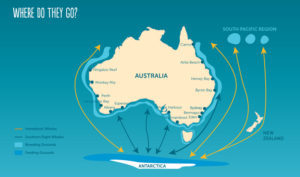
AUS whale migration
The first excursion I took with my husband was a boat trip on nearby Moreton Bay. The whale-spotting boast leave from Redcliffe a few times daily and its proximity to Brisbane makes it an easy day trip. We went close to the end of the season in October and it was a great day out on the water. We saw one or two whales, but unfortunately we weren’t very close to them. We’d also spotted them from the beaches near us—but again they were too far out to get a good look.
Hervey Bay changed everything. This sleepy seaside town on the Fraser Coast is roughly a three hour drive from Brisbane, so a weekend was required to make the most of a day on the water and we were far from the only people doing this. On Saturday morning, the packed marina saw fully-loaded vessels leaving several times an hour with multiple tour operators using it as their base. Because Hervey (pronounced “Harvey”) Bay is such a quiet town, I didn’t expect all the ruckus. It was only then that I understood what it meant to be in the “Whale Watching Capital of Australia.”
Our boat, aptly named Whalesong, cruised onto the bay’s shimmering waters and I gripped two cameras tight with anticipation. Families and travelers from around the world smiled nervously as they sipped hot coffee to stay warm during the winter morning. My husband and I planted ourselves on the ship’s bow hoping for the best vantage point to see the ocean on both sides of the ship. I tried to appear calm, but anticipation of what we might see was getting the better of me.
As we cruised, information was given to us about the type of whale behaviors we could see and the captain said were “guaranteed” to have sightings on this calm sunny day. I took that comment with a grain of salt as nothing in the world of wild animals is guaranteed—but I like optimism, so I tried to believe. Next came the whale song of the humpback at full blast over the speakers. Judging from the smiles on the faces of my fellow whale-spotters, optimism is contagious.
Soon, the whales were spouting in the distance—many of them. My heart pounded as I cursed the limits of my zoom lens and got nothing but fuzzy fins. My husband and his giant new lens fared better than I, but it didn’t take long for the curious giants to move right in. What started as a calm morning had turned later to higher than average swells. It was incredibly difficult to hang on to the boat and the camera at the same time and I eventually gave up.
Sitting on Whalesong‘s bow was an experience I’ll not soon forget. These playful giants who head to Queensland’s warm waters for an eating and breeding holiday are nothing short of magnificent. Their slick black and white tails slapped at the crystal blue waters as though they were applauding the human ability to stay standing while the waves tossed our boat around. They came in groups of twos and threes and seemed to enjoy surprising the two-legged creatures on deck with their antics.
We watched them breach and spy-hop and you could swear they were looking you in the eye. Our cameras were little match for the action, but it didn’t matter. Seeing something the length of 5 cars glide below you and knowing it is the same weight as eleven elephants is a feeling it’s difficult to describe—uneasy and magic in equal measure.
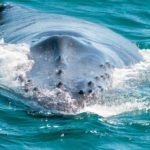
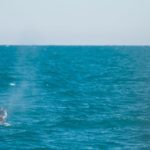
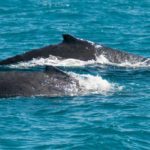
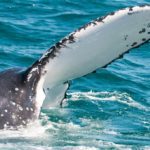

Whales have not always had such a joyful time on the Australian coast as whaling was one of this nation’s first industries. Luckily the 1960’s saw the beginning of a shift in attitude against hunting whales and legislation for their protection was drafted and eventually enacted—but not for all species. The killing of sperm whales (mainly) continued until 1978 with tens of thousands disappearing from the seas of the Southern Hemisphere.
Now, with acts firmly in place and coastal regions patrolled, whales numbers have increased to the point at which you are “guaranteed” to see them. There is even an app for tracking your own sightings and seeing those of others to know where along the coast to find them. And even though the marine protection act states that boats must remain 100 meters (328 feet) from whales at all times, the latest development includes tours where you can swim with the whales. I must run along now as I’m late for another date with the cetaceans. The Greek word for “huge fish” tells me I simply have no choice. Care to join me?
The post A Whale of a Time appeared first on Worldwise Publications.



